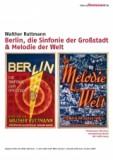| Reviews & Columns |
|
Reviews DVD TV on DVD Blu-ray 4K UHD International DVDs In Theaters Reviews by Studio Video Games Features Collector Series DVDs Easter Egg Database Interviews DVD Talk Radio Feature Articles Columns Anime Talk DVD Savant Horror DVDs The M.O.D. Squad Art House HD Talk Silent DVD
|
DVD Talk Forum |
|
|
| Resources |
|
DVD Price Search Customer Service #'s RCE Info Links |
|
Columns
|
|
|
Berlin: Die Sinfonie der Großstadt & Melodie der Welt
Ruttmann, who spelled his given name variously as Walter and Walther, was born in Frankfurt in 1887 and died in Berlin in 1941. Academically trained as a mathematician, musician, and painter, he entered the world of filmmaking by creating a series of animated shorts featuring an interplay of abstract form, color and music. Some of these animations were commercial commissions, others were purely experimental.
The surviving commercial animations included in this set soft sell tires (Der Sieger, 1922, 3:01), liquor (Das Wunder, 1922, 2:45), a florist (Das widergefundene Paradies, 1925, 5:26), health tonic (Der Aufstieg, 1926, 2:44), shortwave radios (Spiel der Wellen, 1926, 2:44), and newspapers (Dort wo der Rhein..., 1927, 5:27), while the surviving experimental animations include the sequentially title Opus I-IV, created between 1920 and 1925, totaling 23:39.
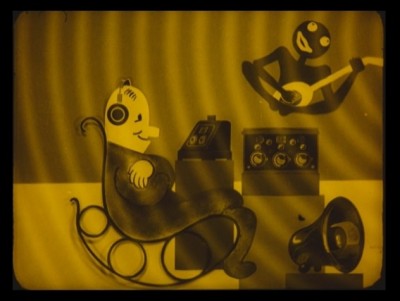 | 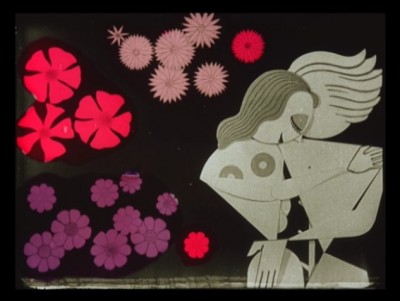 |
Leaving animation behind, Ruttmann embarked on his most ambitious project in 1926, a 65-minute experimental documentary about Berlin featuring a montage of city scenes with symphonic accompaniment. While inspired by the Paul Strand and Charles Sheeler's filmic ode to New York City, Manhatta (1924), and Alberto Cavalcanti's to Paris, Rien que les heures (1926), Ruttmann's Berlin: Die Sinfonie der Großstadt (Berlin: Symphony of a Great City), owes at least as much to Dziga Vertov's non-narrative documentary films, made with hidden cameras, seeking deeper truths apparent only through dialectic montage (Kino-Pravda).
Though shot over the course of a year, Berlin: Die Sinfonie der Großstadt's narrative structure is the life of the city during a single day from dawn till midnight. The film is divided into five acts each with an opening and closing title card, but without narration or intertitle. The acts cover the waking of the city (I Akt), the beginning of the day for school children and workers (II Akt), the bustle of mid-morning street life (III Akt), lunch and the end of the work and school day (IV Akt), and finally the city's varied night life (V Akt).
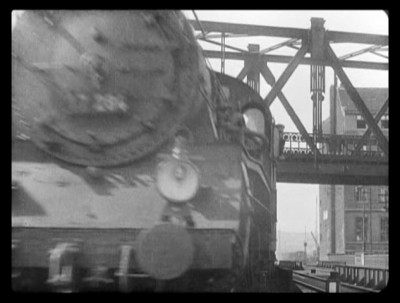 | 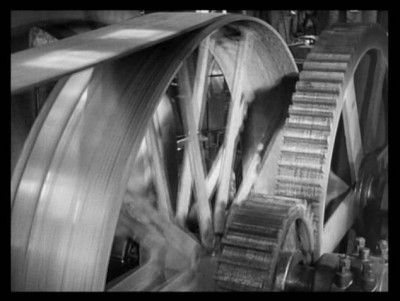 | 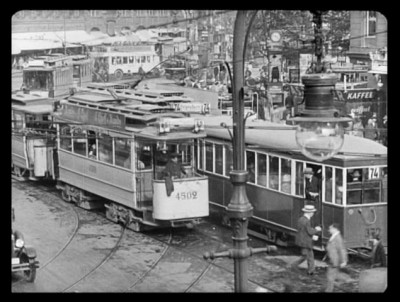 |
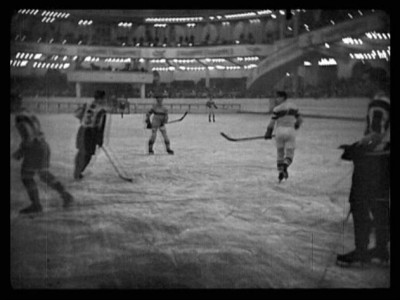 | 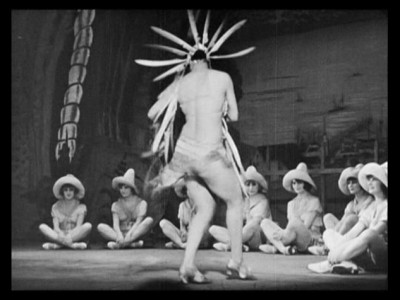 | 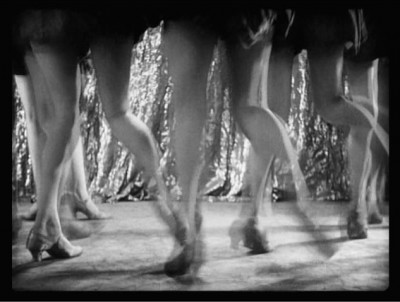 |
Although shot almost entirely with static cameras, Berlin creates a sense of frenzied movement through the use of montage, the frequent use of objects and people in motion, and through a driving symphonic score by Edmund Meisel.
Berlin was made during the Golden Era of the Weimar Republic as the nation was emerging from a long period of hyperinflation and tumultuous politics. Many Germans then believed that Germany could steer a centrist course clear of the perceived extremes of fascism or communism, and in this light, Ruttmann's de-emphasis on politics in Berlin is understandable, as is the good cheer of Germany's first talkie, Ruttmann's 48-minute travelogue Melodie der Welt completed in 1929, just as the Golden Era ended with the sudden death of liberal statesman Gustav Stresemann.
Financed by a German ocean liner company, Melodie der Welt, uses a sailor traveling the world as the narrative device, yet rather than present the world as a sequential series of locals as the sailor would have experienced it, Ruttmann creates a collage, grouping like things from around the world--beautiful women, music, stage production, work, children, and the like--leaving the sailor to offer only occasional reaction shots that don't mesh with the surrounding material. Melodie der Welt is ultimately a flawed, but engaging look at the world through liberal German eyes just on the eve of the rise of fascism and world war.
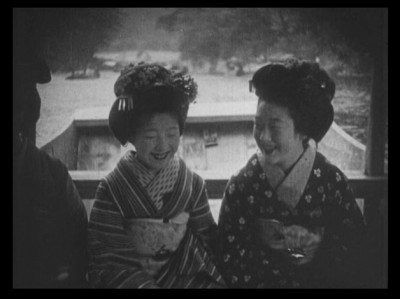 | 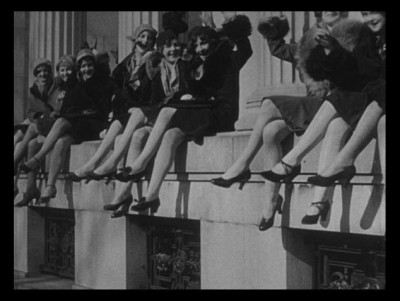 | 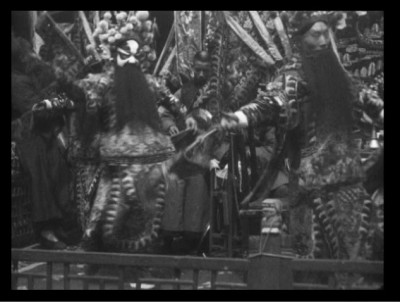 |
Also included in the set are a gallery of 23 paintings and drawings done by Ruttmann between 1911 and 1920, the eleven-minute radio play, Weekend (1930), and the seven-minute short In der Nacht (1931).
Presentation
This 2-disc set was released by Edition Filmmuseum, a label founded by six German-language national archives and the Goethe-Institut.
Video:
The materials incorporated in this set suffer from missing frames, print damage, and interlacing, yet look better than they previously have with Berlin: Die Sinfonie der Großstadt having received a restoration in 2007, and Melodie der Welt and many of the shorts being newly reconstructed and restored from disparate film elements.
Audio:
The monaural audio is distributed to the left and right front speakers. The audio is generally free of extraneous noise, while the symphony and piano scores sound robust.
No subtitles are offered on this release. While the loss of optional subtitles is of no consequence at all on the silent shorts or Berlin, and of only minimal import on Melodie der Welt, the lack of subtitles on Weekend, In der Nacht, and for the 86-minute German-language radio documentary Walther Ruttmann, der Visionär bewegter Rhythmen will diminish the value of this collection to non-German speakers.
Extras:
Besides the films, radio play, and drawings of Walter Ruttmann identified above, this set also includes a 1987 German-language radio documentary, Walther Ruttmann, der Visionär bewegter Rhythmen (86 min.); an unrestored version of Lichtspiel Opus 1; full-length four-panel comparisons of existing prints of Dort wo der Rhein and Melodie der Welt from which the final prints were assembled; photo galleries of lobby cards and original artwork for Berlin: Die Sinfonie der Großstadt (23 images) and from the Congress of the Independent Film at the Swiss castle of La Sarraz in 1929 (21 images); a 20-page booklet with essays in German, English, and French; and additional ROM texts by and about Walter Ruttmann.
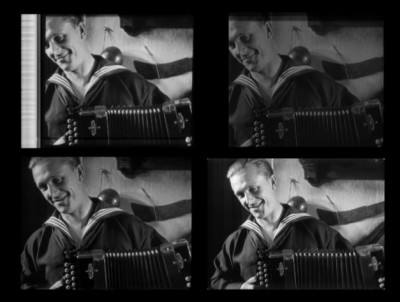 | 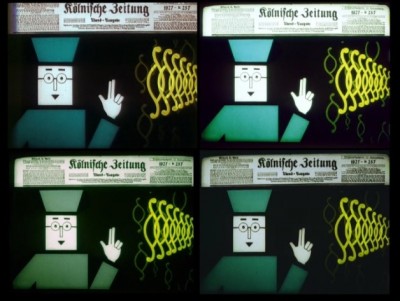 |
Final Thoughts:
This two-disc collection of all of Walter Ruttmann's surviving work up to 1931 is flawed only by the lack of optional English subtitles on a couple of pieces. Even without the subtitles though, this set is highly recommended for all fans of early avant-garde cinema and documentaries. Much of this material has never been available on DVD before, and none of it has been available with this level of audio and video quality.
|
| Popular Reviews |
| Sponsored Links |
|
|
| Sponsored Links |
|
|
| Release List | Reviews | Shop | Newsletter | Forum | DVD Giveaways | Blu-Ray | Advertise |
|
Copyright 2024 DVDTalk.com All Rights Reserved. Legal Info, Privacy Policy, Terms of Use,
Manage Preferences,
Your Privacy Choices | |||||||









